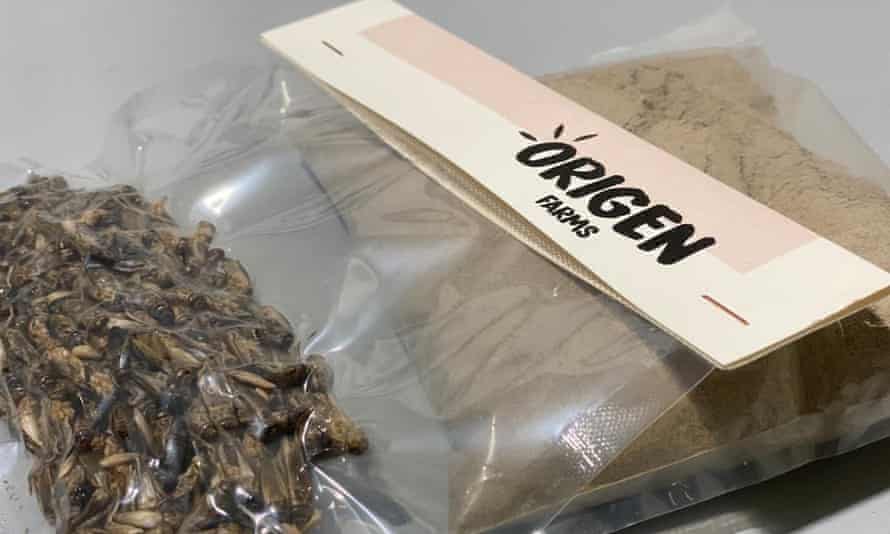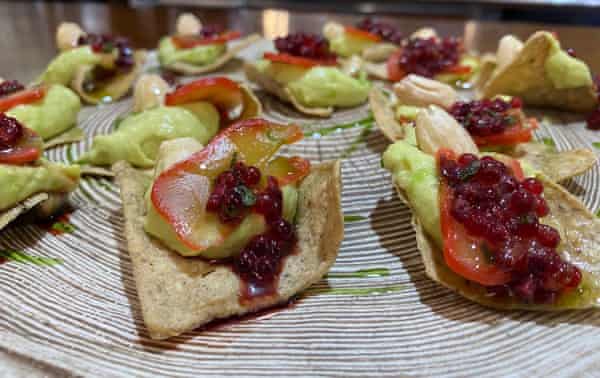Starter bug idea – put tortillas and cricket chips on the menu | Insects
[ad_1]
Tthere are no gargantuan mastiffs or quad shepherds watching over the hundreds of thousands of newborn animals that tumble and crawl around an unlikely farm among the wind turbines, highways and patchwork fields of this corner of Castilla-La Mancha, in central Spain.
There are also no fences to enclose them. The plastic bins, shelves and insulated walls of a unit located in a windswept industrial area do the job perfectly. But whatever Origen Farms lacks in land, tradition and rural romance, it aims to make up with innovation, enthusiasm and resilience.
Founded almost two years ago, the company breeds a single animal: Acheta domesticus, the house cricket.
The farm is one of a growing number of companies in Europe and elsewhere seizing the protein possibilities of insects. But while others focus on growing insects for pet food or animal feed, the Spanish startup is having its antennae training in the human market.
During each 35-day cycle, the farm produces three tonnes of crickets – 80% of which are ground into high-protein flour for culinary use, including pasta, snack bars and crackers.
Some of the 250,000 young insects grown in the 30 ° C (86 ° F) breeding room will be mixed with imported Mexican corn and reincarnated into tortillas or totopos (tortilla chips), seasoned with sesame or chipotle. Others will be dried and packaged as snacks, while the rest will be frozen and shipped as animal feed.
The company, based on the outskirts of the town of La Roda, near the town of Albacete, is the brainchild of three local childhood friends now in their thirties: Andrés GarcÃa de Lis, Francisco José Tébar and José Antonio Torres .

“We were looking to start a sustainable and profitable business,†says GarcÃa de Lis. “We looked at various things, from spirulina to other types of insects, but ended up going with crickets for human consumption because it’s a young market that could be profitable.â€
Their model is built around the humble cricket and its usually overlooked nutritional benefits. In addition to being up to 70% protein, animals contain iron, zinc, calcium and amino acids.
And yet, perhaps unsurprisingly, some residents of the city – whose economy depends primarily on traditional forms of agriculture, as well as paint-making and other industries – have questioned the wisdom of the business.
“A lot of people saw the potential of this; others said we were crazy, â€says GarcÃa de Lis. “Our families love us very much, but they also have to wonder if we are crazy. But we have collected the money.
Their initial investment of € 15,000 (£ 13,000) each, supplemented by bank loans and grants, financed the air-conditioned industrial unit, with its breeding room, nursery and large growing space still slightly cronenbergian, where 300 tubs house the crickets as they reach their full size of just over 2cm, fed a diet of grains, vegetables and the gentle, carefully calibrated drops from the irrigation system.
The last stop in the insects’ journey is the refrigeration room, where the freezing temperature ensures what GarcÃa de Lis calls una muerte dulce: a sweet death.
Production is hampered by Spanish law which does not allow the transformation of insects into flour for human consumption. Instead, the frozen crickets are shipped to the Netherlands to be made into flour. Once the flour comes back, it can then be used to make tortillas and totopos for people to eat, which is permitted by law.
“There are companies here in Spain that are very willing to partner with us and develop the technology to deal with the bugs, but we’ll have to wait until we get the green light before we can really do something scalable.” , says GarcÃa de Lis.

They have sold around seven tonnes of frozen crickets so far – although they had to restock completely after storm Filomena hit in January, bringing freezing temperatures and snowfall not seen in 50 years. GarcÃa de Lis, Tébar and Torres arrived at the factory to find the locks frozen and the pipes burst.
“We had to clean and disinfect everything because excess humidity breeds bacteria and fungi,†GarcÃa de Lis explains. “We saved everything we could, but it was another massive expense and we had to start over and look for new cricket colonies that we loved in Murcia.â€
The trio plan to sell flour and totopos from July. A 200g packet of totopos, containing 40g of protein, is expected to cost € 3.50 to € 4 (£ 3 to £ 3.50). They hope to expand production to Latin America, starting with an organic line and branching out into mealworms, spirulina and meat substitutes.
“The future will depend on how things go, but our goal is to find partners who will help us expand our ideas in other countries, and develop other lines with resources derived from crickets and d other insects, such as droppings. [insect faeces] for agricultural fertilizer, chitin and meat substitutes â€, explains GarcÃa de Lis.

They are also working at two franchise sites, where they will build a unit and provide equipment and training to anyone with € 300,000 (£ 260,000) looking to break into the cricket market.
Tébar uses the cricket flour in a pudding served at his family’s restaurant next door, while Torres reports making it a rather fine risotto – and the company is keen to work with the chefs to develop the product’s potential. For now, however, the plan is to focus on the Mexican-inspired range.
“In Mexico, they eat chapulines (grasshoppers) in tacos and with other things, â€GarcÃa de Lis explains. “And besides, everything Mexican is really in fashion right now, from taquerÃas in mezcal, so it’s a marriage of the two.
Sign up here for the Monthly Farm Animal Update to get a roundup of the best farming and food stories from around the world and follow our surveys. And you can send us your stories and thoughts to animalsfarmed@theguardian.com
[ad_2]
